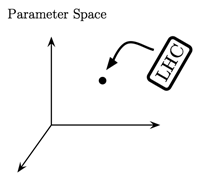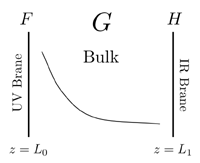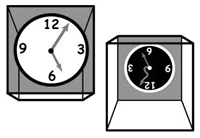The LHC Inverse Problem : Summer/Fall 2005

|
|
Best of All Possible Worlds
|
With Nima Arkani-Hamed, Gordy Kane, and Liantao Wang.
Publications
Notes
A(QCd)S/(CCWZ)FT HLS/LH : Spring 2005

|
|
A Moose Model of the Universe
|
One of the remarkable facts about physics is that different models of the ultraviolet can yield the same infrared phenomena. This fact explains why we don't say that Newtonian gravity is wrong just because we know about Einstein's general relativity, or why we still teach Maxwell's electrodynamics even though electromagnetism is replaced by the electroweak interactions at high energies. Newton's and Maxwell's idea are still relevant for low energy physics, and we shouldn't be surprised that at sufficiently high energies or sufficiently short distances, their theories are superseded by more complete descriptions.
This ultraviolet/infrared separation is the reason we need to build ever more powerful particle accelerators to probe the high energy frontier. We cannot figure out the details of high energy physics simply by doing really accurate experiments at low energies; there will remain a fundamental ambiguity unless we actually probe high energies directly. Indeed, the Large Hadron Collider (LHC) being built at CERN in Geneva is trying to figure out what theory replaces the Standard Model of particle physics. Of course, nothing we will learn at the LHC will invalidate the successes of the Standard Model; like Newton's and Maxwell's theories, the Standard Model will still be a very accurate description of physics at sub-LHC energies.
Another aspect of ultraviolet/infrared separation is that if a theoretical model has desirable infrared properties but questionable ultraviolet properties, then there is very likely a different ultraviolet model with the same infrared physics. I studied this possibility in the context of Little Higgs (LH) theories. By deconstructing the AdS/CFT dual of a certain LH theory, I not only reproduced the known formalisms of CCWZ and HLS, but I also found that the model could actually arise from a scaled-up version of QCD (the theory that describes how quarks form protons and neutrons).
The original title of this work was a bizarre acronym soup: A(QCd)S/(CCWZ)FT HLS/LH. Scaled-up QCD is also generically referred to as technicolor (the "C" in QCD stands for "chromo", i.e. color), hence the final title "Little Technicolor".
This ultraviolet/infrared separation is the reason we need to build ever more powerful particle accelerators to probe the high energy frontier. We cannot figure out the details of high energy physics simply by doing really accurate experiments at low energies; there will remain a fundamental ambiguity unless we actually probe high energies directly. Indeed, the Large Hadron Collider (LHC) being built at CERN in Geneva is trying to figure out what theory replaces the Standard Model of particle physics. Of course, nothing we will learn at the LHC will invalidate the successes of the Standard Model; like Newton's and Maxwell's theories, the Standard Model will still be a very accurate description of physics at sub-LHC energies.
Another aspect of ultraviolet/infrared separation is that if a theoretical model has desirable infrared properties but questionable ultraviolet properties, then there is very likely a different ultraviolet model with the same infrared physics. I studied this possibility in the context of Little Higgs (LH) theories. By deconstructing the AdS/CFT dual of a certain LH theory, I not only reproduced the known formalisms of CCWZ and HLS, but I also found that the model could actually arise from a scaled-up version of QCD (the theory that describes how quarks form protons and neutrons).
The original title of this work was a bizarre acronym soup: A(QCd)S/(CCWZ)FT HLS/LH. Scaled-up QCD is also generically referred to as technicolor (the "C" in QCD stands for "chromo", i.e. color), hence the final title "Little Technicolor".
Publications
Notes
Gauged Ghost Condensation : Fall 2004
The theory of Ghost Condensation (GC) is a consistent way to break Einstein's famed symmetry between space and time. However, this space-time symmetry is the foundation of General Relativity, Einstein's wildly successful theory of gravity, and in general, GC is very constrained by precision tests of gravity. In the fall of 2004, we discovered Gauged Ghost Condensation (GGC), a slight deformation of GC that allows space time symmetry to be violated without making violent modifications to gravity.
With Hsin-Chia Cheng, Markus Luty, and Shinji Mukohyama, we study the implications of the theory of GGC and show how it is connected to many other proposals for slightly modified gravity. Because this theory is a simple extension of the consistent framework of GC, GGC is in our oponion the easiest way to understand the dynamics of these modified gravity theories. Because GGC allows violations of space-time symmetry to be almost entirely independent from modifications of gravity, we have the freedom to ponder exotic new scenarios for cosmic dynamics.
With Hsin-Chia Cheng, Markus Luty, and Shinji Mukohyama, we study the implications of the theory of GGC and show how it is connected to many other proposals for slightly modified gravity. Because this theory is a simple extension of the consistent framework of GC, GGC is in our oponion the easiest way to understand the dynamics of these modified gravity theories. Because GGC allows violations of space-time symmetry to be almost entirely independent from modifications of gravity, we have the freedom to ponder exotic new scenarios for cosmic dynamics.
Notes
AdS/CFT and the Littlest Higgs : Summer 2004

|
|
Warped Dimensions
|
In the theoretical high energy physics community, there are two main avenues of contemporary research. The first is loosely called String Theory, where theorists explore the properties of UV complete theories (i.e. theories that make sense up to arbitrarily large energies). The second is usually referred to as Phenomenology, where theorists construct models that may only be valid up to a finite energy but which have the power to predict what we will see at the next generation of particle accelerators.
One of the most interesting ideas coming out of String Theory is the so-called AdS/CFT correspondence, which is a proposed duality between a non-gravitational theory in four dimensions (CFT) and a gravitational theory in five dimensions (AdS). At first, it might seem like such a duality would have no phenomenological implications, because our universe appears to be a gravitational theory in four dimensions. In turns out, however, that by introducing "branes" into the AdS picture, the dual theory is an approximate CFT with gravity, something that has the potential to model our universe.
More interestingly, with a bit of ingenuity the brane-AdS theory can be modified to model the Higgs mechanism, the central feature of the Standard Model of particle physics. Because the Standard Model is a phenomenological model, it is not UV complete, but via the AdS/CFT correspondence, we see hints that the Standard Model might be embedded in an interesting UV complete framework.
With fellow grad student Itay Yavin, we apply the AdS/CFT correspondence to the "Littlest Higgs", one of many models of the Higgs mechanism. The Littlest Higgs has the advantage of being an economical extension of Standard Model (unlike the Supersymmetric Standard Model which introduces many more particle types) and of being a beautiful example of the Higgs boson arising from (and later triggering) spontaneous symmetry breaking. In other word, we have constructed a UV complete extension of the Standard Model which draws on some of the most fascinating ideas from both String Theory and Phenomenology.
One of the most interesting ideas coming out of String Theory is the so-called AdS/CFT correspondence, which is a proposed duality between a non-gravitational theory in four dimensions (CFT) and a gravitational theory in five dimensions (AdS). At first, it might seem like such a duality would have no phenomenological implications, because our universe appears to be a gravitational theory in four dimensions. In turns out, however, that by introducing "branes" into the AdS picture, the dual theory is an approximate CFT with gravity, something that has the potential to model our universe.
More interestingly, with a bit of ingenuity the brane-AdS theory can be modified to model the Higgs mechanism, the central feature of the Standard Model of particle physics. Because the Standard Model is a phenomenological model, it is not UV complete, but via the AdS/CFT correspondence, we see hints that the Standard Model might be embedded in an interesting UV complete framework.
With fellow grad student Itay Yavin, we apply the AdS/CFT correspondence to the "Littlest Higgs", one of many models of the Higgs mechanism. The Littlest Higgs has the advantage of being an economical extension of Standard Model (unlike the Supersymmetric Standard Model which introduces many more particle types) and of being a beautiful example of the Higgs boson arising from (and later triggering) spontaneous symmetry breaking. In other word, we have constructed a UV complete extension of the Standard Model which draws on some of the most fascinating ideas from both String Theory and Phenomenology.
Publications
Notes
Ghost Condensation and Lorentz Violations : Spring 2004

|
|
Symmetry Breaking
|
In 1886, Michelson and Morley conducted an experiment that proved that there was no "luminous ether." The idea that light waves could propagate without a propagation media contradicted everything that was known about wave physics at the time, but this crucial realization was the foundation of Einstein's theory of special relativity. In essence, if there is no ether, then there is no preferred rest frame in the universe, so all non-accelerating observers should observe the same physical phenomena.
But what if there were a preferred rest frame? Today, we know that there is an interesting rest frame, namely the Cosmic Microwave Background, but this does not disprove Einstein's claim. This would be like holding up a stapler to prove that the universe is not rotationally invariant: the stapler itself is not rotationally invariant, but the law of physics that govern the stapler are indeed rotationally invariant. Similarly, we have shown to a very high accuracy that not only is physics invariant under spacial rotations, but it is also invariant under "space-time" rotations, and we call the combination of these two symmetries Lorentz invariance.
In the fall of 2003, Nima Arkani-Hamed and colleagues presented a novel way of breaking Lorentz invariance. They call the theory Ghost Condensation, and it provides a way to study Lorentz violations within a completely consistent theoretical framework. This spring, I am working with Nima to study the bounds on Lorentz violations from existing experiments to see whether or not Ghost Condensation is an experimentally viable theory. The goal is to place bounds on the parameters of the theory, and then, if the theory has not been excluded, propose an experiment to search for the novel physical phenomena that the theory predicts.
But what if there were a preferred rest frame? Today, we know that there is an interesting rest frame, namely the Cosmic Microwave Background, but this does not disprove Einstein's claim. This would be like holding up a stapler to prove that the universe is not rotationally invariant: the stapler itself is not rotationally invariant, but the law of physics that govern the stapler are indeed rotationally invariant. Similarly, we have shown to a very high accuracy that not only is physics invariant under spacial rotations, but it is also invariant under "space-time" rotations, and we call the combination of these two symmetries Lorentz invariance.
In the fall of 2003, Nima Arkani-Hamed and colleagues presented a novel way of breaking Lorentz invariance. They call the theory Ghost Condensation, and it provides a way to study Lorentz violations within a completely consistent theoretical framework. This spring, I am working with Nima to study the bounds on Lorentz violations from existing experiments to see whether or not Ghost Condensation is an experimentally viable theory. The goal is to place bounds on the parameters of the theory, and then, if the theory has not been excluded, propose an experiment to search for the novel physical phenomena that the theory predicts.
Publications
Notes

